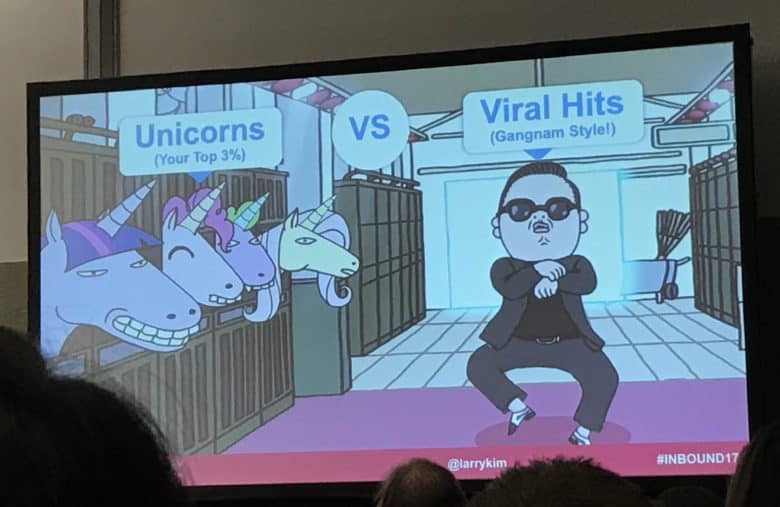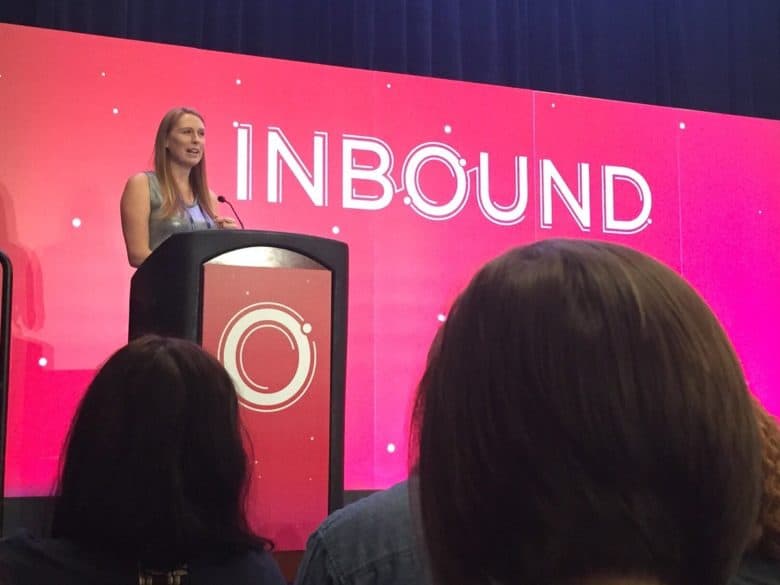This past week, 20,999 other professionals and I had the wonderful opportunity to attend Hubspot’s Inbound Marketing & Sales conference in Boston, MA. While there, I sat in 11 insightful sessions, 2 spectacular spotlights, and 4 fantastic keynotes, and I learned a lot! I thought I would share just a few highlights.
Larry Kim’s Crazy Unicorn Marketing Theory
Takeaway: Focus on your best performing content.
Larry Kim, previously of Wordstream and now working on MobileMonkey, gave a lively presentation on Wednesday about focusing on your best content (unicorns). With his pink and purple, unicorn-themed powerpoint, Kim informed the audience that approximately 98% of the work that marketers are doing is going nowhere. For example, last year, he wrote 300 blog posts and only 8 (2.6%) made a difference to his business.
“The future of content marketing is winner take all.”
He emphasized that marketers need to adjust content strategies in order to take into account that Facebook and Google Algorithms are favoring content that garners high levels of engagement.

Kim went on to explain how to find unicorn content by tracking user engagement rates. He provided a guideline, called the ‘Unicorn Marketing Power Law,’ where 85% of the value comes from 5% of the campaigns. You want to focus on the top 3%.
He then explained that when marketers find a unicorn they should, “jump off the marketing treadmill and milk it to death!” by boosting on social, creating additional supporting content (like infographics, videos, webinars, etc.) and then pushing it across all channels.
Learn more about Kim’s presentation topic from this article he wrote on Medium, The 10 Best Online Marketing Strategies to Make You a Unicorn.
Cultural Conditioning is Mucking Up Our Marketing
Takeaway: If you’re not aware of it, cultural conditioning could really be messing up your marketing strategies. By investigating commonly held marketing beliefs and being willing to take risks to test them, it can result in stronger campaigns and greater ROI (whether it’s measurable or not).
As the marketing manager for a company that offers SEO services, I couldn’t pass up the opportunity to hear from the Wizard of Moz himself, Rand Fishkin. So I made sure to attend his spotlight session on Thursday.
His presentation examined the biases and conditioning that exist in many workplaces. For example, the preference for employees to work in-office instead of remotely (despite studies showing that remote work can increase productivity) or the tendency to place people who work over 40 hours per week on a pedestal (even though it’s net-negative to productivity and is damaging to employees’ health).

Within the marketing industry, we have similar biases and conditioning that we need to break from in order to be successful. He highlighted a handful of marketing myths and explained how they might be turned on their heads, including:
- The belief that investments must be measurable (even though some of the best channels to reach an audience are hard to measure);
- Every channel must be ROI positive (Whiteboard Friday used to be Moz’s worst performing blog post each week and now it’s their highest performing content each week);
- And search investments are either SEO or PPC (many people don’t realize just how many clicks are going to things like snippets, images, product listings, etc.).
Rand encouraged the audience to ask themselves, “How is cultural conditioning biasing me?” the next time they go to make a strategic or tactical marketing decision.
Want to see the full presentation? You can watch the video here or just check out the slides here.
The ABC’s of Persuasion
Takeaway: There’s a lot of research out there about how you can persuade people in your copy (and a lot of it is really intuitive) but we can get more out of it by being more deliberate.
On day 2 of the conference, Nancy Harhut of HBT Marketing gave a whirlwind of a presentation as she listed out 26 words and copy constructs for persuasion. Amidst all the oft repeated principles and concepts found in your average marketing textbook (i.e. social proof, overcoming objections, guarantees, and information gap theory), there were a few gems that were new (at least to me).
R is for Rational (paired with the emotional). Because people tend to make decisions based on emotional reasons and then later justify the decision based on logical reasons, it’s a good idea to use both at the same time. The example that Nancy provided here was an ad by BMW which enticed the customer with the emotional phrase, “Drive a BMW to the Beach for your Next BBQ” but just underneath, a logical reason was provided to back up the emotional decision, “Only $275 per month.”
V is for the Von Restorff Effect. The Von Restorff Effect predicts that when multiple, similar things are presented, the one thing that is most different is most likely to be remembered. Nancy pointed out that this is why marketers started to use emojis in email subject lines and why emails with subject lines that apologize (ie “Oops! Here’s the email we meant to send.”) are more likely to catch a reader’s eye – they stand out.
Z is for the Zeignarik Effect. The Zeignarik effect states that people are more likely to remember interrupted or incomplete tasks. One example that Nancy gave of this was a hotel loyalty program that granted the customer a free night at their hotel after ten stays – but the first box was already checked off. This serves to motivate the customer to finish checking off the remaining boxes.
Marketers are Terrible at Marketing
Takeaways: Inclusivity can not only make your business more welcoming to your customer, it can also result in higher sales, reduced risk, and increased brand affinity and loyalty.
Since Inflow focuses on marketing for eCommerce, I made sure to attend a couple of Casandra Campbell’s sessions to see what insights she might offer – she’s Shopify’s Content Marketing Lead.
In her Inclusive Content Marketing session, she explained that marketers are terrible at marketing because, despite our best efforts, we can’t help but approach what we’re doing from our own perspective. Of course, personas can help but there’s still so much we can do to be more inclusive.
Some of her suggestions included:
- Leveraging technology to provide greater access (examples include video and podcast transcripts and using alt text to describe images on your site).
- Using inclusive copywriting (tips here included using neutral pronouns, limiting the use of humor and cultural references, and keeping language simple – Casandra recommended using Hemingwayapp.com for this).
- Using diverse images (some stock photography sites that offer more diverse images include: bigstockphoto.com, stocksy.com, and depositphotos.com).
- Looking outside of your team (by surveying your audience, interviewing customers, exploring trends, and working with external consultants).
- Hiring a diverse team (Casandra recommended having your hiring team take Harvard’s Implicit Association test in order to discover unconscious biases and using Textio to test job descriptions to ensure that they’re speaking to people of diverse backgrounds).
Casandra also mentioned one of my favorite social experiments – The Ketchup Question – from Silicon Valley leadership engineer, Leslie Miley. The experiment, as described on the Reply All podcast, takes a look at where people keep their ketchup (in the refrigerator or the cupboard?) and how this can help result in a more diverse team of problem solvers. Be sure to check it out here; it’s pretty fascinating.
Put on Your Lab Coat and Run Some Experiments
Takeaways: It’s important to use the abundance of data that marketers have access to, but it’s just as important to make sure you’re asking the right questions and using the right data.
Brian Massey of Conversion Sciences was the picture of a mad scientist as he walked up on stage wearing a white lab coat — and then explained the lab coat was a demonstration of authority marketing.
He then treated the audience to a thorough explanation of how to better test our marketing campaigns and demonstrated the process of creating an effective landing page.
He covered a number of tools and tests as we moved through the landing page’s creation. From headline (he recommends using usabilityhub.com to conduct preference tests) to layout (use Tobii to conduct eye tracking tests and Hotjar for heat-mapping).
Ultimately, his presentation highlighted the importance of large sample sizes and balancing both qualitative and quantitative data.
Books
Book recommendations were also a popular thing for speakers to include in their presentations and I noticed a couple that were repeatedly held up as “THE book for…” or a “Must read!” so I figured I would include them here as well! After all, we could all stand to step away from the screen and read a book every now and again. Why not learn a little something while you’re at it, too?
I can’t personally speak to the value of these books, but you can bet that I’ll be picking up a copy of each so I can find out what all the fuss is about.
Source: Inflow

